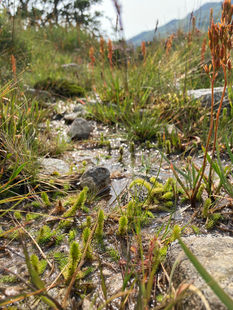Flies
43 species of fly have become extinct in England in the last 200 years, 10 of which are shown below

Species: Belida angelicae
Extinct: 1936

Species: Clitellaria ephippium
Extinct: 1850
© John Reinecke
© Hectonichus


MARSH CLUBMOSS
Lycopodiella inundata

This living fossil is in fact a type of fern, belonging to a strange relict family of plants which dominated the earth millions of years ago.
-
Rarity: It occurs in roughly 100 heathland sites across England & Wales, but at many of these exists at perilously low numbers.
-
Cause of decline: Historically loss of heathland, with more recent declines linked to changing heathland management and fragmentation of sites.
Background
Marsh Clubmoss is a living fossil, which first appeared on the planet 400 million years ago, thriving during the Silurian and Carboniferous eras. It is virtually unchanged from the plants our vertebrate ancestors would have seen when they first emerged from the oceans.
The species was once widespread across the extensive heathlands and wet mires in the UK; but as these habitats were destroyed over the last two centuries these populations became more fragmented and eventually most were wiped out.
In the 21st century we are still struggling to conserve this species, as many of its sites no longer support the high quality wet heath it needs to survive in.
The last stronghold for the species is in the New Forest National Park, which is the only location supporting a network of interlinked sites
Ecology and Conservation
Unlike the angiosperms, Marsh Clubmoss lack flowers, and instead reproduces using spores, borne from structures called sporangia. They were the trail-blazers of the plant family - the first species to start capturing Carbon dioxide in industrial quantities, and as fossil evidence suggests, the first species to harness the power of fungi and establish symbiotic mycorrhizal relationships.
Nowadays most members of this family are extinct, and the remaining ones tend to occur in habitats close to their original ones, on windswept mountain tops, damp heaths and bog edges. They do not cope well with excessive competition from vascular plants, nor with pollution or agricultural improvement to land.
As such Marsh Clubmoss now occupies a fraction of its former range, and in England is confined to wet heaths and bogs, often in increasingly isolated sites. While some large populations still occur, many of the sites in the southeast have been dying out in the last two decades, and many other sites need drastic work in order to maintain populations of this plant and other species reliant on damp bare ground and early successional habitats.
Our Work
Our work on this species focusses on maintaining a monitoring network of all Marsh Clubmoss sites across England and Wales, allowing us to analyse how populations are changing over time and the factors which are influencing this.
One of the patterns we are particularly concerned about is the dramatic decline in SE England, matched by increases in far western populations.
At sites where populations are showing catastrophic declines we aim to intervene to halt this.
Over the last decade we have trialled a range of methods to boost populations, focussing on creating micro-habitats of bare exposed peat, and working with landowners to maintain favourable grazing regimes to keep these habitats open.
We have recently started to trial plant translocation techniques, with a long-term view to returning plants to extinct sites.







